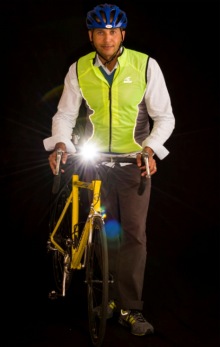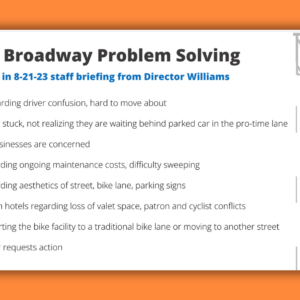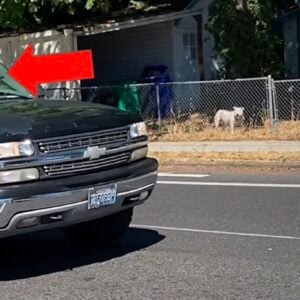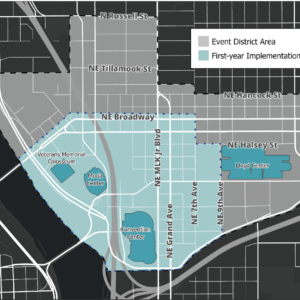
The days are getting shorter and that means more of our travel trips are being made in low-light and dark conditions. In an effort to promote visibility, TriMet is gearing up for their annual — and award-winning — “Be Seen. Be Safe” promotional campaign. The idea behind the effort, says TriMet, is to “educate people with simple steps we can all take to stay safe when walking and biking.”
According to their own study, on average, about 30 percent of collision incidents throughout the TriMet system occur in dark or dusk conditions. Statewide, Oregon Department of Transportation (ODOT) data shows that in 2012, 23 of the 60 fatal pedestrian/motor vehicle collisions either happened at night or were caused in part by a lack of visibility.
TriMet’s campaign will begin when Daylight Savings Time ends on November 3rd. Similar to last year, TriMet will deploy volunteer “shiny street teams” that will canvass bus and MAX stops sporting hi-vis apparel and sharing safety tips. The street teams will be out in force, says TriMet, during the week of November 4-8th. Last year over 70 volunteers worked 20 different locations. New for 2013, TriMet says they’ve coordinated with Portland Public Schools to get high-schoolers on the teams. The students will work before and after school, distributing reflective items to other students on campus.
In addition to the street teams, TriMet will try and blanket local and social media with “Be seen” messaging, editorial content, TV commercials, and so on.
Learn more at TriMet.org/beseen.





Thanks for reading.
BikePortland has served this community with independent community journalism since 2005. We rely on subscriptions from readers like you to survive. Your financial support is vital in keeping this valuable resource alive and well.
Please subscribe today to strengthen and expand our work.
I forgot my headlight on Friday and became a partial ninja-cyclist on the way home. Probably best just to throw it in the bag as a habit this time of year. We should have them on in rainy conditions as well…
I ride with dynamo-powered lights on all the time. I just never have to think about lights!
I run a bright light with daytime running lights up front (B&M IQ FLY RT http://www.peterwhitecycles.com/b&m-hl.asp) and a bright tail light with reflector on the back (B&M Toplight Line Plus http://www.peterwhitecycles.com/taillights.asp#rackmounted). Locally, I know Joe Bike has some good options and some knowledge to help you out. http://www.joe-bike.com/accessories/generator-hubs-and-lights/
Edwin
Dweendaddy,
I used to have dynamo lights on my city bike too… Until someone ripped it off the other day! Any concerns about someone taking yours? Now I’m thinking I’ll just get the strap-on kind and take them on/off whenever I lock up.
With so many rechargeable lights these days, the benefits of a dynamo are decreasing relative to the advantages of a removable light. Of course, you have to remember to recharge it, but at least you don’t have to keep using up batteries!
I haven’t used one…I use a couple $60-$80 self contained rechargeable battery lights…but depending on the the type of, duration and frequency of riding, dynamo lights seem like a great lighting option.
I’m not well familiar with dynamo light designs, but there may be light heads that have an easy disconnect capability somewhat like many battery powered lights have. If there are no dynamo light heads with that feature, it’s probably something dynamo light designers could work up.
Jonathan, a couple of co-workers have switched to using the Magnic lights. They’re powered by magnetic fields from your spinning rims, but the lights are easily removed and shoved in a bag, just like a battery light. I hear Clever Cycles and Joe Bike have them so far. One drawback: no standlight capability (not in 1st generation).
Both workers say they are adequately bright (only slightly less bright than the best dyno lights) and there is no drag whatsoever.
http://clevercycles.com/blog/2013/08/13/game-changer-magnic-light/
I wish they’d bring back the Pioneer Courthouse Square event. I don’t need to win anymore, but I could be useful as a judge (at least, until I leave the country).
I dare someone to load up a paintball gun with a mixed batch of brightly colored paint and mess up the sides of TriMet buses.
When the police catch you and ask WTF you were thinking just tell’m that the buses were hard to see because they weren’t colorful enough.
Disclaimer: I’m not responsible for the YouTube worthy tackling you get when the cops tase you.
Please don’t aim your $300 headlight in my eyes. Thank you.
Please dont ‘strobe on bikepaths either
If it is bright enough to make road debris visible at night the strobe is too bright to be used at night.
Daytime, sure, light up those inattentive drivers on that “strong and fearless” route (Barbur, Hwy 30, TV Hwy, see a pattern?) but at night a light that is continuously ON is not just polite to the retinas of fellow cyclists but serves to all allow drivers to track you location in between blinks.
It is very easy to lose visual target lock on a bicycle in any lit urban setting if their lights blink off for any visually noticeable period of time.
So be polite, don’t strobe at night: we don’t want to see you dead either.
Sorry, unintentional rhyme at the end.
Anybody want a peanut?
Ha! Your reference made me laugh. Thanks for that…
FWIW CaptainKarma, the biggest problems I have are not as much with the $300 headlights, which tend to have well-focused beams and aren’t blinding if properly aimed. I have more problems with the $100 ones, certain VERY popular models of which have inexcusably broad beams, and canNOT be aimed so as to avoid blinding people. (For the record, I ride with a well-focused light that I built for under $100).
Agreed about bike-path etiquette: if you have one of those broadcasting MagicShine lights, PLEASE dim it way down or turn it off on the Springwater and other shared-but-dark paths. Those suckers are so blinding you’re seriously impairing the ability of oncoming cyclists to see where they’re going. And if you have a higher-end light with a nice tight beam, make sure it hits the path a few yards in front of you like a car headlight, rather than aiming straight out front.
Steady lights for safety! Dynamo lights while the price tag may seem initially high, think of all the batteries you’re saving! Also think of the hazards your flashers are doing to other road users, your own night blindness, pedestrians, passengers in cars with disabilities etc. https://bikeleptic.wordpress.com/2013/01/04/all-lit-up/
I saw a guy riding down Gaarde last week with The Best Headlight set-up I have ever seen. He was keeping his momentum on the downhill, or I would have tried to stop him to ask where he got them/what they were.
Two very bright steady beams mounted high on the front fork, to see the road and hazards on the road surface; one or two flashers on his handles, and great reflectivity on his jacket and panniers.
Bikes may be a different issue, but as far as walking goes, this is more “blame the victim” propaganda. The law requires drivers to stop for people in a crosswalk, for instance. They’re required to stop regardless of what color clothing the people are wearing. This type of campaign allows drivers to refuse to stop for pedestrians unless they’re dressed in screaming yellow, and it allows them to claim, after hitting them, that they couldn’t see them because they were (in the words of the police report) “wearing dark clothing”. The media consistently ask for this info from the cops, or the cops volunteer it. It has nothing to do with whose fault the crash was, but activist judges and activist juries are writing the bright clothing for walkers meme into to de facto law!
“…This type of campaign allows drivers to refuse to stop for pedestrians unless they’re dressed in screaming yellow, and it allows them to claim, after hitting them, that they couldn’t see them because they were (in the words of the police report) “wearing dark clothing”. ” Doug Klotz
Point out where this type campaign allows people driving to refuse to stop for people walking, under the conditions you’re claiming.
“…activist judges and activist juries are writing the bright clothing for walkers meme into to de facto law…” klotz
Show us an example of where judges and juries have written this down in ‘de facto law’. If something isn’t really law, I wonder if it’s even possible to do such a thing.
I suppose people could just pretend that visibility defeating measures achieved by camouflage have no effect in civilian life, though there seems to be some very solid indication it works for military and game hunting situations. In a sense, the message behind “Be Seen. Be Safe” type safe walking and biking campaigns, is…take precautions to compensate for the unintentional camouflage effect that clothes you normally wear may have in certain situations.
imo, these events are car-centric victim blaming for both peds and cyclists. safety should be the primary responsibility of the people driving lethal heavy machinery, not their victims.
anyone who has cycled in central amsterdam at night will note “people who cycle” without hi viz clothing or bright lights. the same is also true in portland. in fact, there are thousand of ninjas in pdx and yet…SOMEHOW…i am not aware of a single ninja scofflaw memorialized by a ghost bike.
“…safety should be the primary responsibility of the people driving lethal heavy machinery…” spare_wheel
Safety is a primary responsibility of people driving motor vehicles.
Safety is also a primary responsibility of people that put themselves in the position of being a vulnerable road user. People as vulnerable road users that do not employ basic, simple measures to preserve their lives amongst motor vehicles, are not meeting their personal, primary responsibility for preserving their own welfare.
your statement would have more merit if “accident” rates were not up to an order of magnitude lower in northern european nations where hi viz reflective clothing is very rare.
You do not know what lights or reflectors were, or were not, being used by every rider who is now memorialized by a Portland ghost bike.
I wish they would enforce the head light law. It is so frustrating to be pulling out into an intersection and realize there is a bike approaching with no head light and he is wearing black clothing. Cars get pulled over for having headlights out.
I agree. I’m wary of the potential for victim-blaming of bike riders in dark clothing (I wear a lot of black myself), but I have no problem with a requirement for actual lights–not just reflectors–on bikes, white in front, red in back.
As to people on foot, I see more and more nighttime walkers with at least one light on an armband (and on dogs’ collars), and it seems like a really good idea. I’m not sure where to draw the line between requiring lights on bikes and requiring lights on people’s bodies, though.
The legal requirement is a white front headlight and a red rear light OR reflector.
I attended a debate during the mayoral race where the candidate were asked by a child what they would do to make our streets safer. Hales answered that he would have police pull people over who weren’t properly lit and then, rather than giving them tickets, would give them free lights. Jonathan, Michael or anyone else: Has Mayor Hales made good on this promise?
Would love to see a “Motorists put away your cell phones and pay attention to the road” campaign.
Cyclists need to mind their surroundings. That is when they get hurt is when they suddenly realize that they are in the wrong spot at the wrong time.
Yes me too!
I’d love to see a “motorists has lost their call” device like those brute force cell signal scramblers but with a tight focus area (so you can aim it) and limited range.
You could even see limiting its use to traffic cops: cop sees someone fiddling with something, turns on the radar gun looking device and all of a sudden the driver looks at the phone to see a lost signal right in front of the police.
Evidence, set and match.
Yesterday morning I was riding in San Jose area and it was a bright sunny day. I needed to get into a left turn lane and signaled and crossed two lanes when there was only one car in the second lane very far back. As I waited at the red light, a senior couple stopped at their red and said I was going to get myself killed by wearing black (they must not have noticed the white and fluorescent orange accents). I asked if visibility was the reason they chose to buy a white car; “well, no…” was the reply. I then asked if they thought the brightest colors in the world could save me from a distracted or inconsiderate driver misjudging my speed or presence. “Well, it would help!” he said. I thanked him for his concern and proceeded through the detector-less red light across the empty oncoming lanes as their light turned green.
“… As I waited at the red light, a senior couple stopped at their red and said I was going to get myself killed by wearing black (they must not have noticed the white and fluorescent orange accents). …” Pete
Which raises the question of how big the white and fluorescent orange accents were…what percent of the image that your black clad form presented to other road, was hi-viz.
For walking, biking and other active transportation types, lots of clothing still being used as hi-vis gear, despite the hi-viz material being used on only a very minimal area, as accents or trim.
I recall an article (or paper) that came out this past year noting that visibility of a biker is increased the most when reflective fabric/gear is located along moving parts of the body (i.e. knees, ankles). I find it odd that the photo in Trimet’s campaign is lacking this.
all you need for movement and visibility is a couple pairs of pedal reflectors, no hi-vis clothing required at all.
I’ll ask Speedplay to get right on that… 😉
Reflectives, on bike parts or clothing, require a bright light to be shining on them.
So if the driver is in a car pointed directly at you, with its headlights illuminating the part of your bike or clothing that is reflective, then the reflectives will help.
But that is very often not the case. For example:
– Driver is on a side street, about to pull out, looks out his side window at the street that you are on. His headlights aren’t illuminating you, so your reflectives will do nothing to help him see you; he pulls out in front of your bike.
– Or, you are stopped at a side street and driver is about to make a sharp turn into that street. His headlights illuminate what is in front of his car, not what is to the side of his car, so your reflectives will do nothing to prevent him from knocking you down with the side of his car and running you over with his inside rear wheel.
– Or, you are riding in the bike lane and driver ahead is going to make a right turn. He has no headlights pointing rearward, so your reflectives do nothing to help him see you in his side mirror or over his shoulder, and he right-hooks you.
Consider further that pretty soon it will be both dark and raining. Drivers will be peering at you through windshields obscured by streaming rain, smearing wipers, mist and fog, and you will be hidden in a sea of reflections and lights from from wet roadway, other cars, storefront windows, etc. The little reflector on your pedal or the subtle reflective piping on your sleeve will be easily overlooked.
Oh, and this is the real world, so some of those drivers are tired, distracted, have bad eyesight, are impaired, or are simply very lousy drivers.
If you actually want to be seen at night, and especially on a rainy urban night, you need lights. Good, bright lights. Reflectives on your clothes are helpful but not enough. Pedal reflectors are barely helpful.
I think there are THREE components to optimal conspicuity:
– Good lights, as John Liu points out above, so you’re visible to those whose lights aren’t shining directly at you.
– Reflectors (especially those that move, as pointed out by BURR) and reflective clothing (ideally covering a large surface area) will BLOW AWAY your lights in the vision of those whose lights ARE shining on you.
– Bright colors are helpful in the daytime and especially twilight, when your lights aren’t as visible and reflective stuff is nearly useless.
I think pitting one of these strategies against another is silly. All three have their usefulness in different situations. Sorry for the following car-head analogy, but it’s like arguing whether seatbelts or airbags are better: these days, nearly everyone uses both.
That was a great summary! I totally agree. Except that my cars don’t have airbags, and now I feel inadequate.